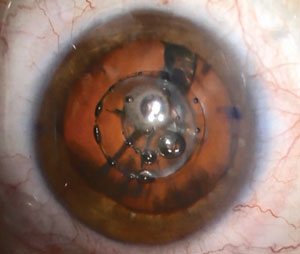 |
 |
A Perfect Circle
Candidates for femto often include those who choose multifocal IOLs or astigmatism management with either limbal relaxing incisions or toric IOLs; the goal is to achieve post-op uncorrected visual acuities that reduce or (ideally) eliminate reliance on corrective lenses.
Despite our surgeons' exceptional talents, traditional cataract surgery may not be meeting the target standard of +/-0.50D—in fact, only 71% of procedures reach that goal.1 Preliminary research shows that femtosecond cataract surgery, when combined with premium IOL technology, can improve these outcomes. One study found that femto cataract cases, compared with a control group, had a statistically better percentage of unaided visual acuity >20/25 (68.6% vs. 56.3%; P < 0.0001) and mean refractive spherical equivalent, although mean absolute error was not significant.2
In our own practice, we examined 200 patients who underwent laser cataract surgery and found that we achieved the intended target 92% of the time, which we attribute to the ability to create uniformly round and centered capsulorhexes. The capsulorhexis is a critical aspect of the cataract procedure, and a uniform size and shape allows for IOL predictability, centration and more effective lens position.
Safety Gains?
As with any new instrumentation, it is important that we evaluate and determine the impact on surgical outcomes in regards to safety.
 | |
| A femto-created capsulorhexis. Note the perfect uniformity of the cut. |
The fragmentation of the lens with the femtosecond laser allows the surgeon to use less phacoemulsification power and phaco time, which is believed to be more gentle to the eye, reducing the likelihood of inflammation and corneal swelling. The laser creates clear corneal incisions that are well formed and water tight, reducing the extent of surgically induced astigmatism and potentially lessening the risk of infection and hypotony. Not all of these have been conclusively borne out in the literature yet; they continue to be investigated by surgeons and comanaging optometrists. Studies have documented reduced effective phaco time, for instance, but not an associated decrease in complications as a result.
However, according to one study, the outcomes and safety of laser cataract surgery improved significantly with greater surgeon experience, development of modified techniques and tecnological improvements. The study evaluated one surgeon's 1,500 femto patients, comparing the first 200 cases to the subsequent 1,300 procedures. The rate of major capsular complications decreased from 7.5% to 0.6% with no cases of dropped nucleus or capsular block syndrome.3
More to Come
Many studies are underway to investigate the procedure's real-world benefits and safety. As comanaging ODs, we must educate our patients on all available cataract options and initiate the discussion of elective surgical options. Doing so demonstrates our ability to provide state-of-the-art care and serves as an opportunity to discuss our role in the pre- and post-op care.
2. Chee SP, Yang Y, Ti SE. Clinical outcomes in the first two years of femtosecond laser-assisted cataract surgery. Am J Ophthalmol. 2015 Apr;159(4):714-9.
3. Roberts TV, Lawless M, Bali SJ, et al. Surgical outcomes and safety of femtosecond laser cataract surgery: a prospective study of 1500 consecutive cases. Ophthalmology. 2013 Feb;120(2):227-33.

